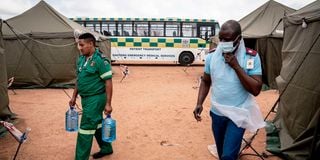S.Africa’s chronic water crisis deepens

A paramedic carries bottled water at a field hospital in Kanana, Hammanskraal on May 31, 2023. An outbreak of cholera has killed at least 23 people near South Africa's capital of Pretoria, as city officials urged residents of Hammanskraal and surrounding areas not to drink from the tap, adding water tankers were being supplied.
South Africa’s long-running water crisis continues to deepen, the outbreak of cholera in one community which claimed 23 lives in recent days being only one of many elements in a complex conundrum which seems, on current trends, insoluble.
The southernmost part of the African continent has much in common, weather-wise, with the East African region, in that both are already water-stressed and both have a high regional vulnerability to global climate change.
With parts of East Africa entering the sixth year running of drought, so too are regions of S.Africa in the grips of multi-year shortages of rainfall.
Groundwater supplies
Worst affected at present are parts of the Eastern Cape province, where winter rainfall was once reliable but is no longer so.
As a result, the region’s largest metro, Nelson Mandela Bay, which has a population of just under 1.3 million people, is teetering on the edge of ‘Day Zero’, when the taps run dry.
Between 2016 and 2018 Cape Town experienced the real possibility of ‘Day Zero’, but was lucky with some emergency groundwater supplies and long-overdue rains combining to head off what could have been a major emergency for over 3.5 million citizens.
The crisis in the Eastern Cape has also affected another urban centre, also the result of an extended drought, but also with much water wastage through leaking pipes and taps that take months to repair, political instability and the effect that has on administration and implementation of new water storage projects, as well as poor management of water infrastructure.
Gqeberha, formerly known as Port Elizabeth, located in Algoa Bay on S Africa's coastline with the Indian Ocean, is a major port, also known for its numerous beaches, which has also been driven close to having no water, and for much the same reasons as the larger Nelson Mandela Bay metro.
This city’s million-strong residents now also face the moment when the taps run dry as its reservoirs and water resources dry up under the impact of an ongoing severe drought, much exacerbated by years of municipal mismanagement.
Failure to maintain water reticulation systems, and stop leaks when they happen, is affecting this city and most others in S Africa, including dozens of smaller centres and towns across the country, even in areas where adequate rains have fallen.
Both Eastern Cape urban centres will run out of water for their residents if there not good, early rains this southern hemisphere winter, now just starting, and with indications that this will be a low-rainfall year.
Both the southern and eastern African regions are directly impacted by global climate patterns, an extended three-year La Niña (the ‘little girl’) Pacific Ocean surface water temperature phenomenon now ending, with climatologists warning that there are indications that a El Niño (the ‘boy child’) counter-phenomenon is almost certain to follow.
El Niño is commonly linked to droughts in southern Africa and extreme rainfall in eastern Africa.
The long-running La Niña oceanic and atmospheric event has, as is typical, contributed to increased precipitation in southern Africa, including several severe flooding events, and drought in East Africa.
The turn-around of this pattern is likely to severely deepen S Africa’s overall water shortage, with its growing population of over 61 million unlikely to receive, overall, the requisite amount of water per head of population.
Climate change, population growth and increasing water scarcity will put pressure on food supply, say the International Panel on Climate Change and the United Nations, with most of the freshwater used – about 70 percent on average – absorbed by agriculture.
Depending on what is being grown and the region in which that is happening, it takes between 2,000 and 5,000 litres of water to produce a single person’s daily food.
According to government statistics, average water consumption in S Africa is 235 litres per capita per day, compared to a world average of 185.
Much of the ‘usage’ is not used at all, but wasted as the great majority of towns and municipalities are heavily under-performing in their supply of fresh potable drinking water, with a significant number of towns and centres at any one time being temporarily in emergency supply or having not at all for weeks on end, as recently was the case for a large portion of the capital city Pretoria/Tshwane.
Climate scientists said, during the last intense El Niño event, that it made much more severe the already more than 2 degrees C increased background average temperature which Namibia, the south-western parts of S Africa and Botswana are already suffering due to global climate change, which expresses itself variously according to where in the world its effects are playing out.
In East Africa, should a full El Niño come into play, drought could easily turn to flooding, especially when intense and relentless downpours arrive on soil hardened by years of unremitting waterlessness.




